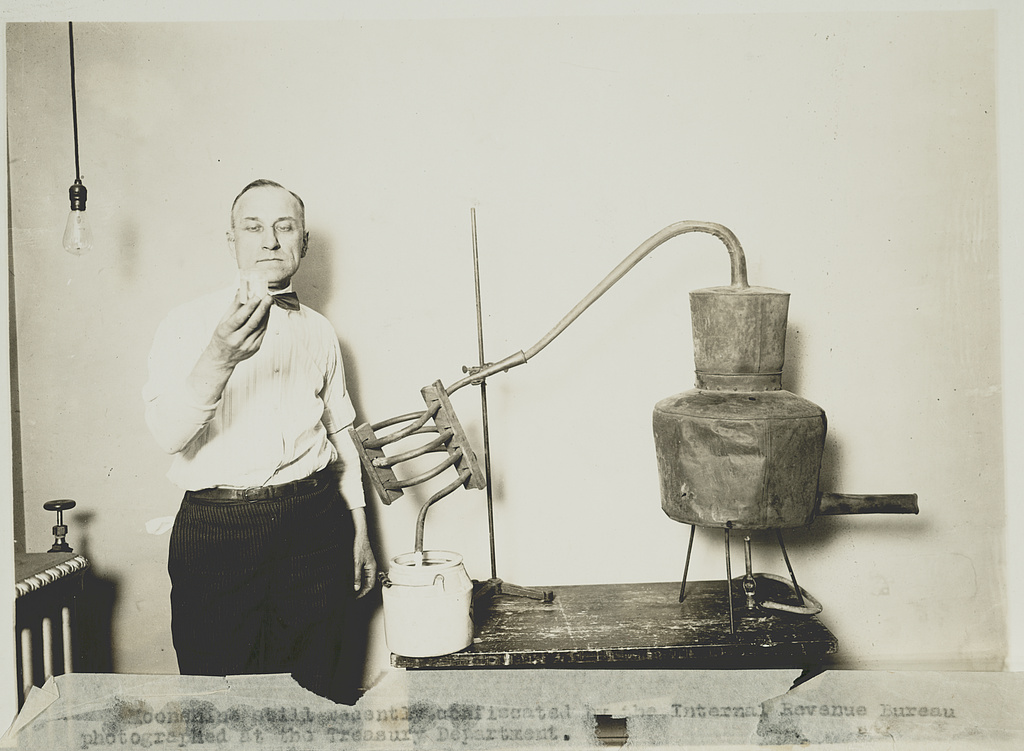Moonshine in America began its long pour decades before Prohibition, stretching back to the postbellum age. Heavy levies on alcohol essentially funded the Civil War, and these taxes made cut-rate hooch an appealing option during Reconstruction. Though the South is probably most commonly associated with moonshine, NYC was home to a large concentration of the clandestine stills. An article in the October 26, 1908 Brooklyn Daily Eagle reported on a building project which accidentally unearthed a great piece of hidden history. An excerpt:
“In excavating for the foundations of the new factory building for the Thompson Meter Company, at Bridge, York and Talman Streets, several most curious walled-up vaults have just been uncovered under the sidewalks of Bridge and York Streets–cave-like places that instantly brought to the minds of a number of the old residents of what used to be the Fifth Ward of Brooklyn, the days of ‘moonshine’ whisky, shortly after the Civil War. Those were great days in the old Fifth Ward, when nearly everybody had a kettle of ‘mash’ heating, and these old vaults, with evidences of secrecy, now that they have seen daylight let into them, have the romantic appearance of being hiding places for unlawfully made liquor.
The Hennebique Construction Company, of 1170 Broadway, Manhattan, is to erect on the plot a big five story structure of reinforced concrete. In order to get the proper room, ten old shacks–one and two story frame buildings of wood–and the ground they stood on, were bought and torn down, under the direction of Israel Pomeranz, a well known excavator. There isn’t a resident of the neighborhood, and there are some whose memory of the ward gone back sixty years, still living there, who can remember the shacks as other than old when they first remember them. When they were built no cellars were put under the buildings and, according to one old resident, the vaults under the sidewalks, with a passageway from an areaway, were built originally to keep provisions in. In post-bellum days they probably made fine hiding places for ‘moonshine.’
A photograph taken by an Eagle photographer the day the vaults were uncovered shows that these caves were of no flimsy construction. Built of both broken boulders and brick and laid in cement of the best quality, the excavators had pretty difficult work to break through the walls. There were six vaults on Bridge Street and two on York, but the two houses torn down on Talman Street had no vaults under the sidewalks. In front on the houses with vaults there were small sunken areas to which two steps generally led. Years ago there were openings from these areas into the the vaults, but of late years the presence of the hollow places were not suspected, it is said, by the occupants of the houses. In one of the vaults photographed there was an old time cask, covered with dust and with one head broken in, of the style of cooperage of years ago, and curious spectators who peered into the recess were at once reminded of the days that led up to the calling out of the militia in the early ’70s, when ‘moonshine’ making reached its most notorious days.
Talk to any of the old residents of the ward–such men as ‘Tom’ Donnelly, the undertaker, of 74 Hudson Avenue, or James Dougherty of 289 Front Street, and they will talk interestingly of those early days, when that part of the present borough was about all there was to Brooklyn. An Eagle reporter saw both recently and they talked of the time when lower Fulton Street bordered fields and when lower Gold Street was about the only really big thoroughfare thereabouts; of old Prospect House, which was on the site now occupied by part of the Y.M.C.A., with its ‘robber band’ that was talked about by every boy in the neighborhood.
This was long before the war, however, and the making of illicit whisky didn’t start, at least as a general activity thereabouts, until after the duty had been put at $2 a gallon on the imported stuff. When certain men did begin making it, though, others soon took it up and the Federal Government had hard wok in preventing it. Some men, mighty well known in later years in politics and for respectability, since dead, got the nucleus of their fortunes, out of ‘moonshine.’ A fair sized still could ‘run’ a barrel an hour of whisky made out of molasses, and twenty-four barrels a day were frequently made and disposed of to certain men over in West Street, Manhattan. The ‘moonshine’ makers could make a good profit if they got a good deal less than a dollar a gallon.”

